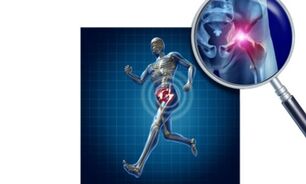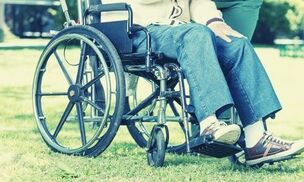Coxarthrosis (osteoarthritis of the hip joint) is a degenerative-dystrophic disease of the hip joint, accompanied by damage to the articular cartilage, bone tissue and periarticular structure and causes persistent loss of joint function.

Osteoarthritis of the hip joint is one of the most severe dystrophic pathologies of the musculoskeletal system. The disease quickly leads to a decrease in physical activity, changes in the nature of a person's movements, often - to the impossibility of movement and free disability. Decades earlier, coxarthrosis was considered one of the "diseases of old age", but since the beginning of the century, high incidence has been noted among young and middle-aged patients, associated with a variety of causes.
Statistics
Osteoarthritis is the most common pathology of the musculoskeletal system and occurs in 70% of adults; coxarthrosis - in 25% of patients with orthopedic profile. Up to 30% of patients diagnosed with coxarthrosis are disabled, have a disability and need joint replacement surgery.
The disease occurs from 20-25 years, the average age of onset of symptoms is 37-39 years, persists with age, associated with the presence of pathology equivalent to the musculoskeletal system, bone loss, etc. In middle-aged patients, the prevalence of coxarthrosis is 11%, in people over 85 years of age - 35%. In children and adolescents, coxarthrosis is the result of congenital dysplasia of the joints, which is observed in 1% of newborns.
Reason for development
The causes of hip joint arthrosis have different meanings depending on the age and general health of each patient:
- congenital disorders of the normal anatomical shape of the joint - femoral neck deformity, congenital hip dislocation;
- deformities of the femoral head due to dystrophic (age-related) processes in the joints;
- traumatic injuries - fractures, dislocations, non-physiological, including sports, loads on joints;
- infectious and inflammatory diseases - tuberculosis, osteomyelitis and others;
- rheumatoid arthritis and other systemic diseases (allergies, metabolic);
- if the exact cause of the disease is not yet known, and it has developed on its own, the term "idiopathic cooparthrosis" is used.

Symptoms of coxarthrosis of the hip joint
Pain is a major symptom. The severity and severity of other manifestations of coxarthrosis depends on many factors, particularly on weight, lifestyle, age. In the early stages, the patient noted moderate and intermittent pain in the hip joint, which occurred mainly during physical exercise and continued on its own. Then the pain begins with light effort, not disappearing at rest, "shooting" at the knee joint. Joint mobility or both joints are limited.
Patients have to limit physical activity, lameness, "gait duck" appears. In the final stage, unusual persistent pain is observed, movement in the hip joint is very limited, walking is only possible with a crutch or crutches, the patient needs help all the time, is disabled.
Development
As the disease progresses, the hip joint gradually collapses and loses its function completely.
There is thinning of the articular cartilage and slight narrowing of the joint space. The bone tissue located under the cartilage becomes denser. At this stage, pain appears after exercise.
In the second stage, cartilage destruction occurs. Marginal osteophytes appear - bone growth. Narrowing of the joint space takes place. Pain occurs while walking, limitation of joint movement (contracture).
In the final stages of coxarthrosis, extensive bone growth, flattening and subluxation of the femoral head occur, the joint space almost disappears. Persistent severe pain, very limited joint movement.

Diagnostic Coxarthrosis
If you experience pain in the groin area, joint movement limitations and other symptoms listed above, you can see a therapist, but a leading physician who diagnoses and treats hip joint arthrosis is an orthopedic traumatologist.
The main method for diagnosing coxarthrosis is radiography. This is an informational method that allows you to accurately assess structural changes in the affected joint. Due to its cost-effectiveness and affordability, shared radiography is still widely used. A more informative (but expensive) method is X-ray computed tomography. Magnetic resonance imaging (MRI) of the joint is also used. It is performed to detect coxarthrosis at the pre-X-ray stage (when there is still no change in X-rays), as well as for differential diagnosis.
Treatment of coxarthrosis of the hip joint
In the early stages of coxarthrosis, with good disease progression, conservative methods using physiotherapy techniques are preferred, including kinesiototherapy, massage, and physiotherapy, in particular water and mud therapy, physiotherapy complexes. Among the physiotherapeutic techniques that have proven themselves well, magnetotherapy can also be distinguished.
Magnetic therapy for coxarthrosis is used for a variety of purposes. Under the influence of magnetic fields in the body, the regeneration process is activated, including in bone tissue, blood circulation is improved. The last point is very important, because in osteoarthritis, the blood supply to the joints is insufficient, and therefore the lack of nutrients to maintain the normal state of cartilage and bone tissue, and this can exacerbate pathological changes in the joints. Increasing blood circulation in the hip joint area helps restore the flow of necessary nutrients to the joint, activating metabolism in bone and cartilage tissue, which is the basis for the positive effects of magnetotherapy on coxarthrosis.
Also, due to increased metabolic processes and the release of certain biologically active substances, the anti-inflammatory and analgesic effects of magnetotherapy are observed.

Dietary therapy is recommended to normalize metabolism and lose weight. Along with a rational diet, it is possible to use additional drugs (active pharmaceutical drugs and additives) that influence metabolic and recovery processes in the musculoskeletal system - based on glucosamine and chondroitin (chondroprotectors), minerals and vitamins, standard plant extracts.
Preparations with anesthetic and anti-inflammatory effects, namely NSAIDs, GCS, muscle relaxants and a few others, are used at all stages of coxarthrosis to relieve pain and inflammation. Its use should be strictly dosed, under supervision and as prescribed by a doctor.
In the second or third stage of the disease, depending on the symptoms and condition of the patient, it is recommended to continue conservative treatment or surgery. Currently, various surgical methods are used, the best results (restoration of joint function and human movement) are achieved with total arthroplasty - hip joint replacement.
Also recommended drug therapy, diet therapy and lifestyle changes, physiotherapy and spa treatments, both in terms of surgery and conservative approaches. Physiotherapy techniques in complex treatments can reduce the amount of medication and load on the body, promote faster recovery after surgery, and improve the general condition of the patient. In particular, magnetotherapy shows good efficacy and tolerance, even in the elderly, elderly patients and people suffering from chronic diseases of the nervous and cardiovascular systems.

Prevention of hip joint arthrosis
Early detection of coxarthrosis at an early stage is very important as a preventive measure. If you find symptoms (pain, limited movement) in the hip joint area, you should see a doctor - first you can see a therapist, then an orthopedic surgeon. The therapist may prescribe treatment for early pain relief, recommend chondroprotectors, and the orthopedic specialist will prescribe special treatment.
Loss of excess weight and normal physical activity, correction of working conditions and lifestyle in general, as well as timely treatment of diseases that can be one of the causes of the development of coxarthrosis (inflammation, infectious diseases of the joints, congenital joint anatomical defects, degenerative diseasesdystrophy).





































